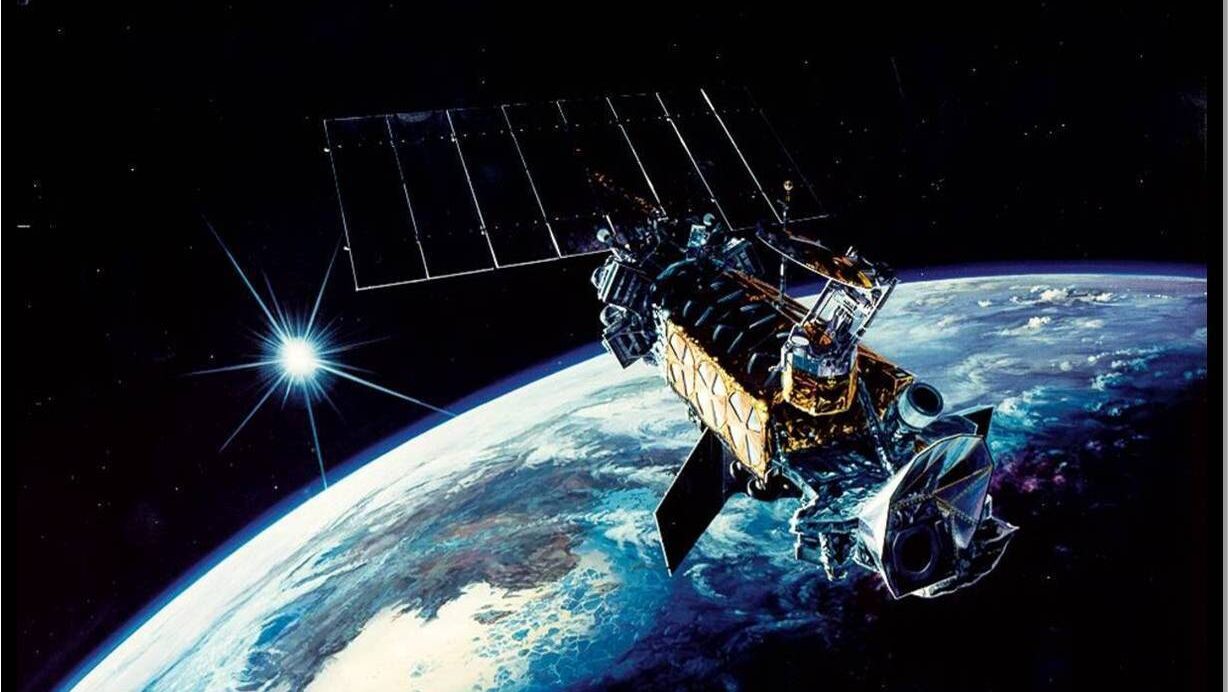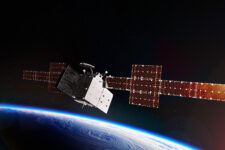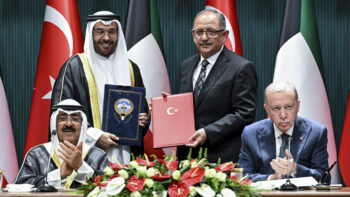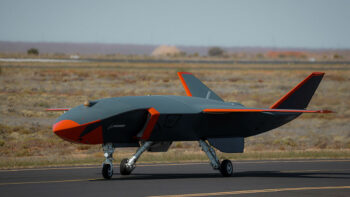
Defense Meteorological Satellite Program satellites, like the one shown in an artist’s rendition here, provide critical strategic and tactical meteorological and environmental data to military and civilian users around the world. (Photo by Scott Prater / 50th Space Wing Public Affairs)
Due to the dysfunction in Congress, countless military programs are on shaky budgetary ground. In the op-ed below, the Mitchell Institute’s Tim Ryan argues the Pentagon cannot wait to upgrade one that’s probably little thought about but crucial: weather satellites.
Monitoring the weather from orbit is one of the Space Force’s less heralded but more impactful missions.
The ability to employ forces, launch munitions and coordinate actions in the terrestrial battlespace fundamentally depends on environmental conditions. Indeed, operations in adverse weather conditions have often proven more harmful to friendly forces than the most robust enemy defenses.
However, the weather mission is often overlooked and taken for granted. Policymakers to warfighters need to realize that the current space-based weather satellites are old, fragile and in dire need of reset. It is past time to complete the modernization of these systems.
The space-based environmental monitoring (SBEM) mission currently depends on the Defense Meteorological Satellite Program (DMSP), a constellation developed in 1962, sustained over the ensuing decades and now well beyond its design life. The constellation is so fragile that one satellite failing will undermine the enterprise’s functionality, with no military-specific backup capabilities available.
Not only is the DMSP constellation old, but it was designed and configured when space was generally considered a peaceful operating domain. The enterprise was engineered and purpose-built to be a large-scale, highly capable, multifunction system. While efficient and capable, it is an example of a “big, juicy target” and is highly vulnerable to enemy attack. Because DMSP has no spares and no on-orbit replacement, losing one satellite would cut the current operational constellation by half. A numerically larger, more disaggregated set of capabilities is needed to reduce risk and increase resilience. The urgency to move quickly is clear.
Weather impacts all levels of warfare, from the operational to the tactical. Understanding the environment of the battlespace is essential to air, land and naval operations. Further, environmental data is integral in closing tactical kill chains to help get the right shooter to the right place at the right time to provide the right effect.
Analysts use imagery and data to determine which sensors have the best line-of-sight and then select the correct weapon given weather and environmental conditions. Weather data will be crucial to Joint All Domain Command and Control (JADC2), which will demand near-real-time weather data to facilitate dynamic operational planning and to respond to evolving battlespace conditions.
As decision cycles accelerate and pressure mounts to dynamically task forces in the span of hours and minutes across an entire theater, near-real-time weather data will become still more important. Consider operations in the Indo-Pacific theater, where US forces must transit long distances and fight through complex weather patterns. The lack of land- and ocean-based sensors leaves a gap between available data and the unknown. Space-based systems are the most effective way to fill this gap.
Knowing DMSP is on its last legs, leaders are augmenting US SBEM capabilities with a family of systems (FoS) approach that combines data from other weather sensors on orbit through partnerships with the National Oceanic and Atmospheric Administration (NOAA) and US allies. While a helpful augmentation initiative, this work-around must not be confused for a direct replacement for DMSP. Certain types of SBEM capabilities, zones of coverage, and refresh rates are military-specific. This is only a bandaid.
Commanders must also ensure data is always available — something that might not be possible in a FoS approach if the US, an ally or a commercial provider find themselves with differing views regarding a specific conflict. To this point, Gen. Glen D. VanHerck, commander of US Northern Command and NORAD, warns against dependence on sources of critical information that might not be available when needed most: “The thing we have to ask is do we want to find ourselves where an individual or a business can impact national security by their perception or their political views?”
The good news is that the Air Force and, after it, the Space Force have made moves to solve the problem, even after two weather satellite programs designed to replace DMSP were canceled in recent decades. Knowing modernization had to occur, in 2016 Air Force leaders decided to replace the aging, monolithic DMPS constellation with two disaggregated, small satellite constellations. These are the EO/IR Weather System (EWS) and the Weather System Follow-on Microwave (WSF-M) programs. This approach has multiple advantages: assured military SBEM capacity, improved resilience, and the ability to modernize the constellation rapidly.
Through EWS and WSF-M, the Space Force has devised a prudent way to modernize the SBEM mission to ensure its long-term viability. EWS and WSF-M are in production but have yet to launch.
It is imperative that these programs remain on track to deliver operational results as soon as possible.
This is easier said than done, given the challenges of unpredictable budgets and surging demands across the defense enterprise. Congress’s inability to pass a real budget and dependence on multiple continuing resolutions is problematic. Not only do such measures deprive the services of the ability to evolve funding profiles as program demands dictate, but they also drive what amounts to budget cuts.
The need for robust weather data to guide effective military decision-making is beyond clear. The current SBEM enterprise risks collapse with the end of the operational life of the DMSP satellites.
The time to “kick the can” and accept another modernization delay is gone. The time to field EWS and WSF-M is now.
Tim Ryan is a senior fellow at the Mitchell Institute’s Spacepower Advantage Center of Excellence.






















